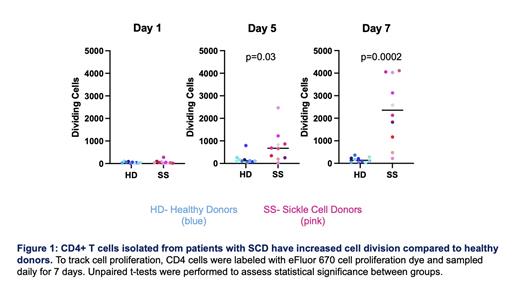Introduction
Patients with sickle cell disease (SCD) have higher levels of inflammation which plays a prominent role in disease pathogenesis. It is well known that individuals with SCD have a higher erythropoietic drive given the ~20 day life span of their red blood cells. We asked whether this increased proliferative drive also occurred in white blood cells (WBC). To characterize WBC turnover we focused on the longest-lived CD4+ and CD8+ T cells.
Methods
Peripheral blood mononuclear cells (PBMCs) were isolated by Ficoll gradient from red cell waste products from consented individuals with sickle cell disease and from leukapheresis products of healthy donors. In ten healthy donors and ten donors with SCD, CD4 and CD8 T cells were purified using EasySep Cell Isolation, labeled with eFluor 670 proliferation dye, and cultured in RPMI with 30% FBS for seven days. Samples were collected daily and stained with naïve and memory T cell markers. CountBright beads were added to obtain absolute cell counts and eFluor 780 live/dead dye was used to capture daily snapshots of cell death. Flow cytometric analysis was performed to track absolute cell numbers, cell division and indirectly monitor cell death. B cells, NK, macrophages, and dendritic cells were similarly tracked. To further probe T cell turnover, T cell receptor (TCR) sequencing was performed on twelve separate aliquots from purified CD4+ T cells at two different timepoints in healthy donors and individuals with SCD. Turnover of clonal sequences was analyzed using the Morisita index.
Results
CD4+ and CD8+ lymphocytes from individuals with SCD experienced more death in culture by day 7 compared to healthy donor controls. In addition, T lymphocytes from donors with SCD were observed to undergo 15-fold more proliferation compared to healthy donors (p=0.0002, unpaired t-test). Immunophenotyping performed on the CD4 and CD8 T lymphocytes showed a propensity for memory cells to undergo proliferation. We also found individuals with SCD had higher turnover in TCR sequences in two timepoints compared to healthy donors (p=0.05, Chi-square). Notably, we also saw increased proliferation of B cells, NK cells, macrophages, and dendritic cells in individuals with SCD.
Conclusion
Our data suggest that T lymphocytes and other PBMCs undergo faster turnover in SCD than in healthy donors, suggesting a stronger hematopoietic drive. Our findings may have important implications for gene therapy since an increased proliferative drive may contribute to an increased risk of developing leukemia in SCD.
Disclosures
No relevant conflicts of interest to declare.


This feature is available to Subscribers Only
Sign In or Create an Account Close Modal